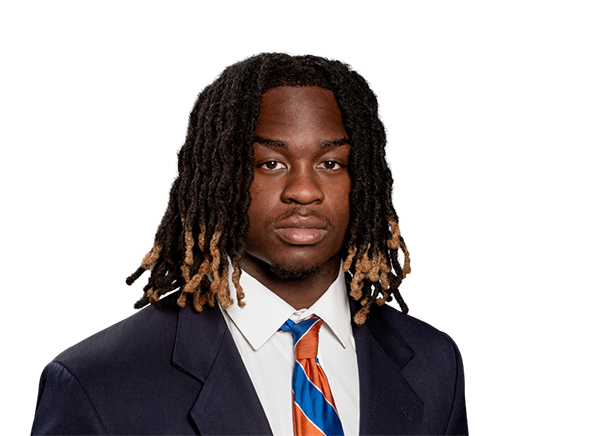It’s fun to look back at players and how they compared coming into the NFL. This article will dive into the prospects of Lamar Jackson and Justin Fields. We will examine how they were compared as passers and overall football players. This could help fantasy owners feel more at ease with Fields, as he could follow a path to fantasy success just like Jackson did.
A Look Back at the Numbers
Before we get into the talent of their play on the field, we look back at the numbers because who doesn’t love numbers? As we know, Jackson played three years at Louisville before coming into the league in 2018. Fields was at Georgia during his freshmen season, then transferred, playing at Ohio State for two years. Let’s look at their passing numbers first:
| School | G | Cmp | Att | Pct | Yds | Y/A | AY/A | TD | Int | Rate | |
| Justin Fields | Ohio State | 34* | 423 | 618 | 68.4 | 5701 | 9.2 | 10.7 | 67 | 9 | 178.8 |
| Lamar Jackson | Louisville | 38 | 619 | 1086 | 57 | 9043 | 8.3 | 8.5 | 69 | 27 | 142.9 |
The early numbers are on Fields’ side, as he may have played in 34 games; he wasn’t a full-time starter until he got to Ohio State, where he played 22 games. Most of his productive games were within those 22 games. Just based on the numbers, you could quickly tell that Fields was a far better passer than Jackson was coming into the league. Fields averaged over 250 passing yards and almost three touchdowns a game.
At the same time, Jackson averaged 238 passing yards and just under two touchdowns per game. The most significant difference was their accuracy, as Fields was close to hitting a 70% completion percentage compared to Jackson, under 60%. Fields was a better passer than Jackson regarding prospects coming into the league. Also, don’t discount Jackson, as he showed he could sling the ball and make plays in the air, but there were flaws in his game to be an efficient passer.
| *2019 | Ohio State | Big Ten | SO | QB | 14 | 238 | 354 | 67.2 | 3273 | 9.2 | 11.2 | 41 | 3 | 181.4 |
| *2016 | Louisville | ACC | SO | QB | 13 | 230 | 409 | 56.2 | 3543 | 8.7 | 9.1 | 30 | 9 | 148.8 |
Even if we took both of their best seasons, it was apparent that Fields could produce with less opportunity than Jackson could. We see that both players had breakout seasons during their sophomore year, showing their talent at a young age. Now it’s time to look at them as runners.
| School | G | Att | Yds | Avg | TD | Rec | Yds | Avg | TD | Plays | Yds | Avg | TD | |
| Justin Fields | Ohio State | 34 | 260 | 1133 | 4.4 | 19 | 1 | -10 | -10 | 0 | 261 | 1123 | 4.3 | 1 |
| Lamar Jackson | Louisville | 38 | 655 | 4132 | 6.3 | 50 | 0 | 0 | 0 | 655 | 4132 | 6.3 | 5 |
We have a clear winner here, with Jackson dominating with the ball on the ground and using his legs to produce big for Louisville. Jackson averaged 100 yards on the ground per game in college. While Fields, in just his time at Ohio State, averaged 39 yards per game. The numbers don’t tell the whole story due to the scheme Ohio State used. Fields had the potential to use his legs more but was used to throwing the ball more often.
Passing Talents
Positives
We need to understand what kind of throwers these quarterbacks were as prospects. Justin Fields looked like a competent and accurate quarterback coming into the league. He showed excellent footwork and mechanics to make a quality thrower for the NFL level. We saw a quarterback who could make the right reads and throw, for the most part, at all three levels of the field. Fields knew where to make the throw to where only his receiver could make the catch. When watching him on the field, you saw the confidence in hitting quick throws across the middle of the field, an area that could bring fear for a quarterback. His mobility allowed him to make accurate throws on the run to help extend the play. The qualities that Fields showcased would make him a quality NFL quarterback.
Posting one Ohio State highlight every day until Ohio State football is back: Justin Fields throws a touchdown to Garrett Wilson to add to the throttling of of Cincinnati. pic.twitter.com/MfpGe2SDvr
— JR Buckeye(@itsJRBuckeye) May 23, 2023
On the flip side, Jackson had other traits that made him stand out as a passer. Jackson had a big arm talent that wowed many scouts coming out to watch him. Jackson showed a side that was able to make plays out of nothing. He could throw off platform to make incredible plays down the field. He ran in an NFL-style offense at Louisville, so adjusting to an NFL offense would come easy. Jackson was also great at working through his progressions. His mobility allowed him to move around in the pocket to help extend the play.
Negatives
An issue with Fields was being unable to deal with pressure consistently. While his mobility helped keep him out of trouble often, he didn’t always seem to know when pressure was coming from behind him. Fields had a below-average awareness of edge rushers. His release needed to be quicker on anticipated throws. His ability to use his eyes to manipulate coverage was a skill that needed work as he invited coverage to his passing lanes. While it didn’t affect him much at college, it was concerned the NFL level. Fields’ deep balls are question marks as there were more than enough times his throws deep needed his receivers to slow down.
Jackson’s issues as a passer were much more apparent, and his accuracy was a concern. Granted, Jackson had a poor offensive line, and his receivers had a drop rate of 12%. It was his footwork that forced bad throws too often. Jackson consistently did not have good footwork or a steady base on making solid throws. Watching him at Lousiville, you saw tight, narrow stands when making throws. His mechanics were a skill in significant need of development and cleanup to succeed at the NFL level.
Other Traits
Both prospects were quiet leaders; they weren’t diva types of players that ran their mouths. They were humble prospects who showed confidence and toughness as a player. In terms of rushing, I think Jackson had a neck-up over Fields. Fields had an average open-field vision as a rusher, as he could make plays with his feet, but Jackson was a true weapon with the ball in his hands. At the NFL combine, Justin Fields ran an unofficial 4.44 40s time as a runner, but Lamar Jackson, at his pro day, ran a 4.34 40s. Fields was a bigger frame prospect as his measurements were 6’3″, 227 lbs., and Jackson was 6’2″, 216 lbs.
Final Thoughts
When looking at these two prospects, you have Fields as the field general type of quarterback who had the mobility to his game. He was accurate and could make necessary throws to push the ball down the field. Fields seemed like a safe prospect that could develop well at the NFL level. As a prospect, he looks like the type of quarterback that the NFL wanted to have who can make throws but also use his legs.
Jackson was the play-making type of quarterback that we know had the mobility and a star talent arm. He was the raw prospect set with game-changing talent at the quarterback position. Jackson paved the way for prospects with the raw elite talent to be taken higher than Jackson. Folks want to compare Fields and Jackson because they are mobile quarterbacks, but now that we look back at them as prospects, you can see they were different types of quarterbacks.
Make sure you subscribe to the #NerdHerd, where you get exclusive content, dynasty/rookie/devy rankings, buy/sell tool, and a bonus podcast too. Dynasty Nerds also recently launched the #DynastyGM tool, a complete game-changer in the fantasy industry. Click here for a free trial. We truly are your one-stop shop for all your fantasy football needs!



















